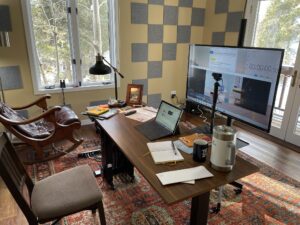Lately, I have come across folks that are facing the challenge of having enough time. When you think about it, it’s our most valuable commodity. It is same for everyone and it’s completely up to us in how we invest it. Take for example billionaire Warren Buffett: he has the exact amount of time as everyone else. He doesn’t have a time machine; Warren only gets 24 hours in a day. We can’t add more time (at least for very long, we all have to sleep at some point). The world talks about time like a commodity. We invest time, save time, squander time, give time, waste time, take time, free time, run low on time, and eventually we all will run out of time. What really matters is how we use it.
To help maximize this commodity, the following series of blog posts and exercises will address:
1. You can’t do it all
2. Priorities and focus on one thing at a time
3. Doing what you love
4. Fire yourself and delegate
5. Done differently is not wrong
Some of the following disciplines are EOS/Traction Tools that I teach as well as ideas from others and some of my own.
1. I can do it all!
If you want anything done well, you definitely can’t do everything. If you’re okay with bumping along, trying to do everything, and “fair to crappy” results, then stop reading now and go work on one of the many tasks you need to do. In EOS, we teach that we only have a total of 100% total work capacity. If your work at 100% equals 50 hours a week, great! Someone else’s may be 35 or 60. No matter how you look at it, we only have 100%. Some would argue they could work longer hours. I would agree, but for how long and at what expense? You can run a car at 120% deep into the red zone on the tachometer, but for how long? You may get that extra 20 miles per hour for a short burst, but if you go too long you will destroy the engine.
To start, you will need to take yourself out for a coffee, sit yourself down, and have a possibly difficult but needed heart to heart with yourself. You need to determine what is truly realistic for your 100%. Outline how much time you have for certain parts of your day and then figure it out. Ask yourself, does this time add up to 100% or 120% or 150% of my actual time? If you feel like you are over that 100% mark, don’t worry. You are not alone. Acknowledging it is your first step. “Every journey begins with just one step.” We will now start with our first, very simple exercise that may help solve your “time” issue forever.
Side note
Keep in mind: slow and steady often wins the race. Rarely does great change come overnight and when changing habits and addressing fears, it usually takes some time. Be pragmatic, patient, and focused on the long-term. Don’t forget to celebrate the victories. Each step is important. Embracing and truly “owning” it is the only way change will come.
Simple Exercise 1:
I know this will sound really simple and ridiculous, but the very first step is acknowledging that you can’t do it all and that if you try, you will not do anything great. Take yourself out for a coffee, leave your phone in the car, and pull out a piece of paper. Split this paper into four columns. Title each column as follows:
1. Work 2. Family 3. Personal 4. Health
Now, list out all the tasks you are responsible for under each heading, being as detailed and specific as you can be. If you have a lot of one off daily occurrences, think about those events throughout the week and try to pull out a rough average of how much time each task should take. Don’t forget to include the travel time associated with each task.
Next, take a few minutes and think about the additional things you should be doing or even what you’d like to be doing. This may include some sort of self-improvement at work to obtain that promotion or possibly something physical/mental health related. Perhaps it’s more experiences with the family, quality time with a partner, or a hobby. Whatever it is, add these items to your columns. After you’re satisfied with your list, go back through and put a time allotment next to each item. Break it down into 10 minute blocks and be honest.
Add all of these minutes and hours up from each column and tally it at the bottom. Add eight hours for sleep and determine your actual total.
Take this number and divide by 24 hours or 1440 minutes.
What is your percentage? 85% 100% 105%120% 150%? How long can you go before you blow up?
Take a minute and absorb it all, embrace it, and own it. No one is pointing a gun at your head to do all of this; it is only that guy you see in the mirror who is forcing you. Be patient! You are doing it all now and you can for a while longer. Realizing all that we are doing and that we really can’t do it is simply a starting point. I promise there is hope and we will get to that in future blog posts.

